Colleen Mondor's Blog, page 7
June 16, 2014
Pippi + Dr. Doolittle + Howl's Moving Castle in a sweet picture book. Really.
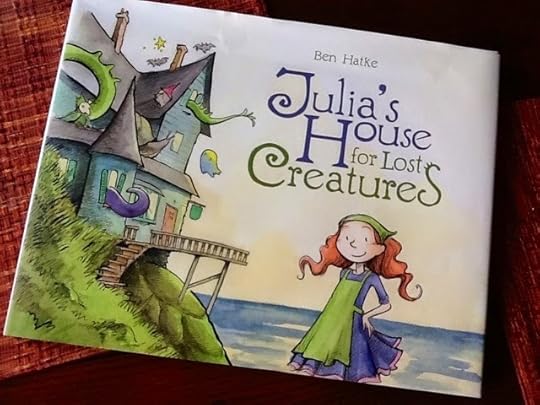
I have a deep appreciation for a well crafted picture book and feel compelled to tell the world just how lovely a recent arrival at my doorstep is. Julia's House for Lost Creatures by Ben Hatke (author/illustrator of the Zita the Spacegirl graphic novels) has everything young readers/pre-readers could want: a great back story, admirable protagonist and creatures great and small that fill the pages (but not in a scary way). The setting is also about as good as it gets combining multiple levels of wish-fulfillment for adult and child alike. Frankly, I think Hatke has hit this one about as far out of the ballpark as you can go.
Julia arrives at her new location a bit magically: "Julia's house came to town and settled by the sea." (This is where I saw shades of Howl's Moving Castle.) With her pink high tops and saucy kerchief, she quickly gets down to the business of filling her quiet and fabulous looking home (fireplace! globe! grandfather clock! books! gramophone! ships in bottles!) with friends. Julia finds these friends by posting a sign outside: "Julia's House for Lost Creatures". All sorts of creatures show up: Patched Up Kitty, a very sad troll, a dragon, a mermaid, goblins, folletti & more. Shades of Dr. Doolittle, yes?
Julia is overwhelmed by all the sudden roommate chaos but finds a way to sort it all out, (the mermaid of course will do the dishes, the ghost is in charge of dusting, etc.), gets everyone to chip in and they all live happily ever after having grand adventures, I'm sure. (Pippi Pippi Pippi!)
Hatke accomplishes the holy grail of picture book writing I think: gentle lesson, glorious illustrations, easy text and sure-fire read aloud pleasure. That he does this with a dash of magic and spunk is nothing less than I would expect from him (see those Zita books for more). This is an author who makes it look easy, which might be the biggest achievement of all when it comes to this tricky medium.
Highly Recommended!

June 12, 2014
Their mission is to profoundly inspire my writing life. That's pretty cool.
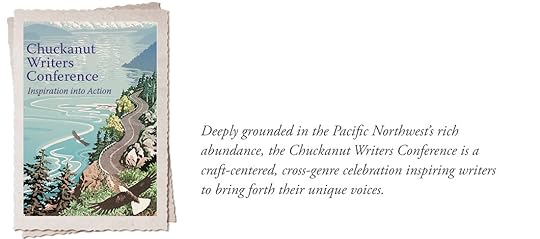
I'm going to attend the Chuckanut Writers Conference later this month seeking some inspiration & general writerly thoughts as I ponder several pieces I'm working on right now.
I think this will be a good thing. There are no plans for "networking" or "making connections". (Don't need to pitch anything, don't want marketing advice, don't want an agent talk.) I just want to listen to some authors and gain some new perspective.
I'm glad those are the only reason I'm attending. Sometimes (most times) thinking about the business of writing really sucks all the happy out of the creative bits (at least to me). But the writing part, that I'm really looking forward to.

June 9, 2014
"Canada brooded in the air and haunted me," Jack wrote.
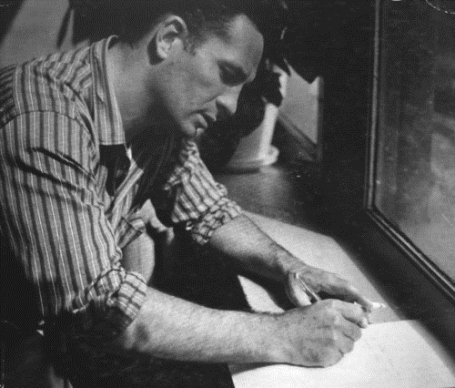
From The Voice is All, a biography of Jack Kerouac by Joyce Johnson:
They clustered in the mill towns where the trains brought them and created enclaves where no English needed to be spoken--self-contained "petits Canadas" like certain neighborhoods in Lowell, where they had their own churches, parish schools, shops, social clubs and funeral parlors. Every Franco-American community had its own newspapers. It was only the virulent prejudice against them that made them choose to be walled off, it was their cultural pride, which they called "la survivance." In Canada they had held out against the English foreigners who had taken their country from them in the eighteenth century. It was now their duty to endure, surrounded by the foreigners of America. In the words of the inspiring voice that reminded Maria Chapdelaine* of her solemn duty, "many centuries hence the world will look upon us and say:--These people are of a race that knows not how to perish....We are a testimony."
La survivance depended upon the stubborn preservation, at all costs, of famille, foi, et langue (family, faith and language), all of which were under threat in the mill towns of the United States."
My father's family emigrated from Quebec in 1929 when their youngest child, my great uncle Ben, was 3. I have long been interested by how the French Canadians fought assimilation so hard--it's particularly amusing to me when people use failing to assimilate as a reason to distrust an immigrant group as I know firsthand how complicated this issue truly is.
My father was American-born, in a Rhode Island mill town in 1939. He left home at age 17 for the USAF and resolutely never looked back but, just like Kerouac, he could not truly leave New England or his family or his faith (or his French-Canadian-ness) behind. For this reason, Kerouac is an endless fascination for me.
[Post title from Jack Kerouac: Selected Letters 1940--1956.]
*The main character from a novel of the same name by Louis Hemon, published in 1913.

June 2, 2014
"I wanted the authenticity of actual awkward teenagers...."
I missed A Birder's Guide to Everything when it came out on the festival circuit last year--did any of you see it? I get so frustrated when the "loud" movies eat up all marketing oxygen and a film like this one disappears quickly. Here's a bit on the movie from the current issue of Audubon Magazine:
The plot of A Birder's Guide to Everything centers on four kids trying to confirm a possible sighting of a Labrador duck, considered extinct since 1875. I'd been asked to check over a draft screenplay to vet its bird content. The movie's premise--chasing a long-gone duck--might seem preposterous. But I was happy to oblige: It isn't every day that someone decides to film a drama built around teenaged birders.
When I first picked up the screenplay, I feared that birding teens would be treated as a bad joke. Fortunately, it was soon obvious that director and co-writer Rob Meyer had tremendous respect and affection for his characters.
That same feeling was apparent later, when I visited the Birder's Guide set. Everyone working on the film, onscreen and off, believed in the project. That belief shines through in the finished film, where the main characters and their personal struggles come across as glowingly genuine.
The duck "discovery" may be the least authentic thing in the picture, but by the time it shows up, that hardly matters. By then, A Birder's Guide has already worked its magic, which you'll be able to see for yourself when it hits the big screen in March.
And, from last year, a bit about how making the movie turned filmmaker Rob Meyer into a birder.
[Post title from the article about Rob Meyer. Note also the diversity of the teen cast.]

May 29, 2014
"Yes, the jihadi warriors had thoughtlessly burned their own sacred book--multiple copies were destroyed in the fire, Bouya noted."
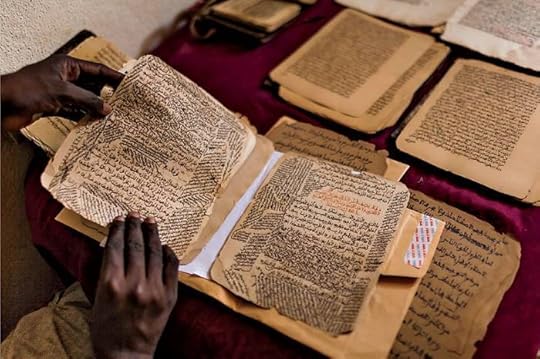
Excellent article up at Outside on the lengths the people of Timbuktu were willing to go to last year to save their long protected (and centures old) books and manuscripts from an invading jihad. Here's a bit on what books have always meant to the people of Mali who dwell on the Niger River:
The skies had been smudged with Saharan sands all day, but this blew out at night, leaving an enormous Milky Way overhead. When Scottish explorer Mungo Park first came down this river in 1795, he was astonished by what people requested: they wanted paper. In the 1840s, the explorer Heinrich Barth gave away reams of the stuff and described traders wandering the desert with nothing but books to sell. Illiterate Africa was a myth. Words--books--had always been necessary.
And this is just a taste of what the people of Timbuktu did to save their books:
"Then, in August, we found the solution," Traore said. Late at night, they began to pack up manuscripts, stuffing them into old rice sacks. Just the packing took a full month and involved dozens of men from several book-owning families. Traore hired five donkey drivers to carry the thousands of manuscripts--no one could count them all--out of the dispensary around midnight, every night for a week. They loaded the donkeys, and then Traore's 72-year-old grandfather, the retired guardian, walked point, scouting for jihadi patrols. Each night, they distributed books to a different house, joining the small number of high-priority works smuggled out of the main library by underwear.
Go. Read the whole article. It will make you believe in the goodness of the world again.
[Post pic: Malian calligrapher Boubacar Sadeck consults an ancient manuscript at his home in Bamako, Mali. Photo: Marco Di Lauro/Reportage by Getty Images.]

May 23, 2014
"The answer was short and dismissive. Girls could not be pages."
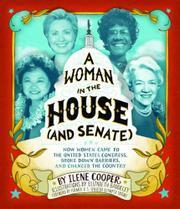 From Ilene Cooper's interview with Booklist in March, here is a bit about her YA nonfiction title A Woman in the House (and the Senate):
From Ilene Cooper's interview with Booklist in March, here is a bit about her YA nonfiction title A Woman in the House (and the Senate):
By the 1970s though, when women were demanding their rights instead of asking for them, many congressmen were growing hostile. When Patricia Schroeder was appointed to the Armed Services Committee, the chair made her and an African American, Ron Dellums, share a chair because, he said, "women and blacks were worth only half a member."
(Dellums was the first African American member of the committee.)
Cooper continues with this bit of her personal story about social security which BLEW ME AWAY:
The week before I graduated from high school, my mother died of a heart attack. The salary she earned as a saleswoman was intended to cover my college tuition--thankfully much less in those days. Still, after she died, it seemed college might not be in the cards for me.
Then my family learned that we were entitled to her Social Security benefits. A few years earlier, this would not have been the case. A husband's Social Security benefits went to his family; a wife's were simply put back into the general fund.
It took a dedicated congresswoman, Martha Griffiths of Michigan, to push for a bill that would reverse this injustice.
All rather startling, don't you think? You can see a short video of Congressman Dellums talking about sharing that seat by scrolling down on this Congressional history page.
[Post title taken from the response Cooper received when, as a teenager, she wrote to her Congressman asking about the Congressional page program.]

May 21, 2014
"The House That Ate the World" (which is not the name of a short story)
Richard Bowes writes some wonderful short stories.
"The Margay's Children" is the sort of Bowe's story that especially appeals to me - it brushes up against his love of New York City, his development of realistic complicated characters in a seemingly mundane setting and his drop-in of sudden and unexpected fantasy. We can call it urban fantasy and if you are familiar with Charles de Lint, for example, then you will know what I'm talking about. This is out-of-the-corner-of-your-eye kind of fantasy, subtle and careful.
It is my favorite kind of fantasy.
In many ways, "Margay" is a typical multi-generational family saga. There is much here of mothers and daughters and some of what that entails. Writing in the first person, the narrator, Richie, identifies himself as the godfather of Selesta, daughter of his old and dear friend Joan Malta. Selesta likes cats which is the thread of the larger story about the Malta family that the narrator slowly unravels.
There are Richie and Joan, who knew each other in their youth as "hippies" and Selesta who is young as the story opens but then it college as it continues. There is Ruth, Joan's mother, and her mysterious first husband (Joan's father) who went missing. Ruth is a pistol - she lives in "The House That Ate the World" (Joan's name for it.)
There is a bit of a falling out and a coming together, as mothers and daughters do. There is sitting on porches and children playing in the water and the announcement of a pregnancy which brings excitement and also some trepidation.
Cats figure into this story. Remember that.
What Bowes does so well in "The Margay's Children", as he does in so many other stories though, is lull you into the scenes on city streets and country porches, in places that would be utterly at home in any realistic novel or story. He lets you see just how easily lives can be different or more than you might expect; how the fantastic hides so easily within the mundane. He is revisiting a fairy tale here but you can read it without knowing that and enjoy it just the same.
Richie and Joan have been friends a long time, he is Selesta's godfather, and yet there is much he does not know. Secrets full everything in our lives and in our world; always there are the secrets.
Finally, what I love the most about "The Margay's Children" is that it is not horror. It is a warm family story at the end as it is at the beginning, which is exactly what I wanted it to be. Bowes would have ruined it by bringing in a true monster; nice to see he didn't take the easy way out.
[You can find "The Margay's Children" in The Queen, the Cambion and Seven Others.]

May 18, 2014
"Because my love's American/blisters blossom on my heart."
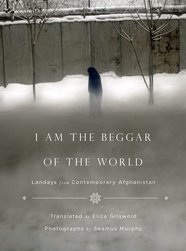 The May issue of Outside has an impressive, gut-wrenching piece by Eliza Griswold on the poetry of Afghanistan and Pakistan's Pashtun women. (It's all online.)
The May issue of Outside has an impressive, gut-wrenching piece by Eliza Griswold on the poetry of Afghanistan and Pakistan's Pashtun women. (It's all online.)
These are words that will stay with you long after you finish reading. Frankly, they are life-changing words that are all the more amazing because most of us would wonder just how capable of poetry these women would be. (When you struggle so much for survival, it is startling to see that you still write poems along the way.) Here's a bit from Griswold:
Women make up roughly half of the 42 million Pashtun people in the borderland. The kind of hardship they know is rare. Some are bought and sold, others killed for perceived slights against family honor. But this doesn't render them passive. Most of the Pashtun women I know possess a rebellious and caustic humor beneath their cerulean burkas, which have become symbols of submission. This finds expression in an ancient form of folk poetry called landay. Two lines and 22 syllables long, they can be rather startling to the uninitiated. War, drones, sex, a husband's manhood--these poems are short and dangerous, like the poisonous snake for which they're named.
And one of the landays:
When sisters sit together, they're always praising their brothers
When brothers sit together, they're selling their sisters to others.
And another by a woman whose brother was taken away to the notorious Pul-e-Charkhi prison:
In Pul-e-Charkhi, I've nothing of my own
Except my heart's heart lives within its walls of stone.
"To ask a woman to sing a landay is to ask what has happened to her," writes Griswold, and it is clear that the things that have happened to the Pashtun women are incredibly difficult. These poems bring new definition to the term "hard life" and they are, in their way, revolutionary.
Griswold has a book out now: I am a Beggar of the World: Landays from Contemporary Afghanistan. It includes photographs by Seamus Murphy, whose photos are also used in the Outside article. I'm really looking forward to reading this book. Poetry was not taught well to me in school - it was a language from centuries ago and never real to me. These landays are reality screaming - I think they would be an unforgettable addition to the classroom.
M.P. Ritger's review of I am a Beggar of the World at the LA Review of Books is a must read as well.
[Post title is a landay from I am a Beggar of the World.]

May 12, 2014
Working men, circa 1910
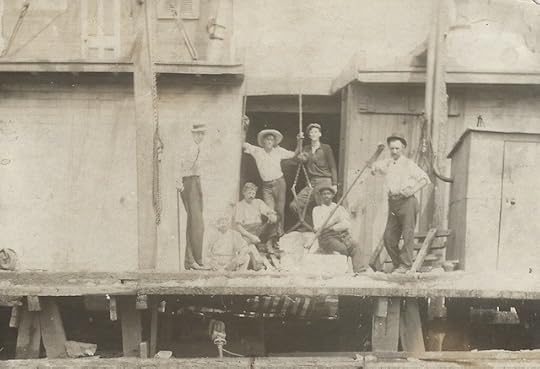
Standing in the center of the photo, with the large brimmed hat, is my great grandfather Thomas Lennon. I believe that those are blocks of ice they are lifting. I know that Thomas worked for a beer wagon at one point (I have a photo of him with the wagon) and this ice might be associated with that job. I also know that he worked at some point as a painter and, according to the 1910 census, as a "laborer".
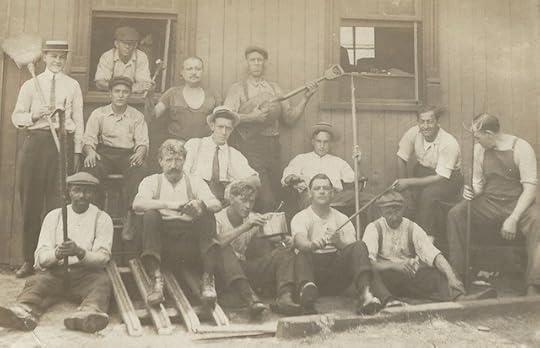
This seems to be the same crew as the top photo - several of the men are in both pictures. Tom is seated in the front, center, with the pot in hand; his hat is off here.
My grandmother told me that her father worked many jobs, wherever he could get work actually. At one point in the 1920s they earned money storing liquor in their apartment for a speakeasy downstairs. They lowered the bottles through a dumbwaiter and she remembered helping her father load it. (Every time she told this story it made her laugh)
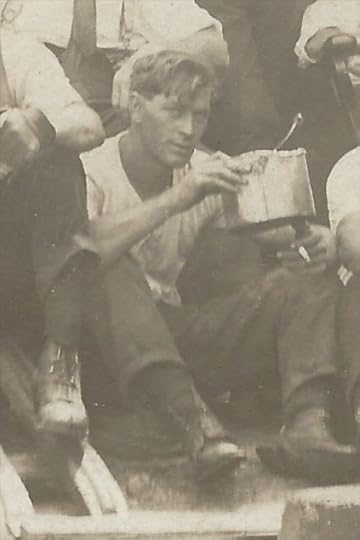 Tom was an Irish American through and through, born in New York as were all of his brothers and sisters. He is about 22 in these photos; they were likely taken right about the time he married my great grandmother, Julia.
Tom was an Irish American through and through, born in New York as were all of his brothers and sisters. He is about 22 in these photos; they were likely taken right about the time he married my great grandmother, Julia.
Tom Lennon remains one of the more compelling and confounding parts of my family history. He is the hero and the disappointment in so many stories. In these photos he is simply a man on the job; in some intrinsic way a central part of what it has always meant to be American.

May 8, 2014
On the upcoming Sally Ride biography - it's excellent
My [starred] review of the upcoming Sally Ride biography by Lynn Sherr has gone up at Booklist. This is a wonderful book and I highly recommend it for anyone who came of age during the shuttle years. It's a great read for book clubs and also a solid title to recommend to teens looking for book reports. (Ride was only 27 when she became an astronaut!)
As much as I knew how impressive it was for Ride to become an astronaut, you don't realize how much of a struggle it was to go against NASA culture until you read her story. There is also how society viewed women for the entire history of the space program. Consider this quote from the book:
A 1958 editorial in the Los Angeles Times had welcomed women on interplanetary flights as mere "feminine companionship" for the "red-blooded space cadet," to "break up the boredom" and produce a "new generation of 'space children'." But, asked the writer, what if the "feminine passenger" (the concept of coworker was not yet on the radar) was incompatible? "Imagine hurtling tens of millions of miles accompanied by a nagging back-seat rocket pilot." Look magazine, Life's popular, photocentric competitor, framed the debate more soberly in 1962 with a cover story entitled, "Should a Girl Be First in Space?" Answer: "[W]omen will follow men into space."
And then there's this one:
In 1965, newspaper columnist Dorothy Roe declared, "Girls who are clamoring for equal rights as astronettes [I swear, she wrote "astronettes"] should consider all the problems of space travel. How, for instance, would they like to wear the same space suit without a bath or change of clothes for six weeks?....How will a girl keep her hair curled in outer space?"
I.Can't.Even.
Sally Ride was one in a million; I wish she had more years with us; I'm sure she would have changed the world even more if given the time.
[Photo courtesy of NASA]





